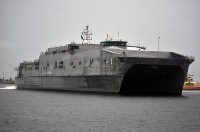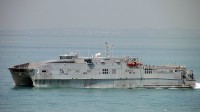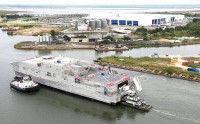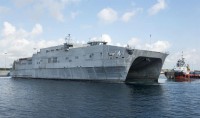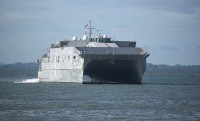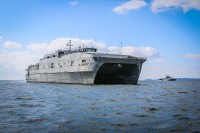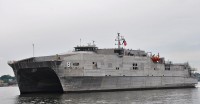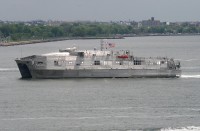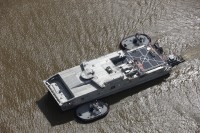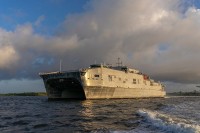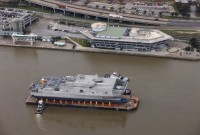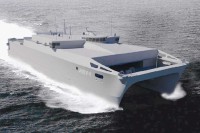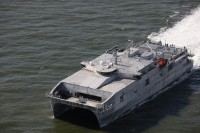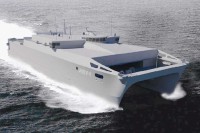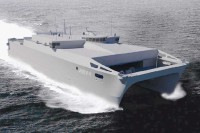Spearhead-class expeditionary fast transport
Basic information
Ship measurements
Machine
- 4 * MTU 20V8000 M71L diesel engines
- 4 * ZF 60000NR2H reduction gears
Personnel
Combat assets
4 * mounts for M2 .50 caliber machine guns
- Landing pad for a helicopter, up to CH-53 Super Stallion/CH-53K King Stallion
- Parking and storage area for MH-60 Seahawk
The Spearhead-class expeditionary fast transport (EPF) is a United States Navy–led shipbuilding program to provide «a platform intended to support users in the Department of the Navy and Department of the Army. The Expeditionary Fast Transport (EPF) program is a cooperative effort for a high-speed, shallow draft vessel intended for rapid intratheater transport of medium-sized cargo payloads. The EPF will reach speeds of 35–45 knots (65–83 km/h; 40–52 mph) and will allow for the rapid transit and deployment of conventional or special forces as well as equipment and supplies.» The vessels are a part of Military Sealift Command's Sealift Program. The class was previously designated as «Joint High Speed Vessel (JHSV)», but was changed in September 2015.
Capabilities
The EPF is able to transport U.S. Army and U.S. Marine Corps company-sized units with their vehicles, or reconfigurable to become a troop transport for an infantry battalion.
The EPF has a flight deck for helicopters and a load ramp that will allow vehicles to quickly drive on and off the ship. The ramp is suitable for the types of austere piers and quay walls common in developing countries. EPF has a shallow draft (under 15 feet (4.6 m)).
The EPF is an aluminum twin-hull catamaran shell containing four diesel engines, rudimentary control facilities for up to 40 crewmembers, and 312 airline-style passenger seats, along with an expansive flight deck on the top. The rest of the vessel is a convertible 20,000 sq ft (1,900 m2) mission bay that can be loaded to carry whatever cargo is needed. Vehicles and cargo are loaded and unloaded by a ramp that can support up to 100 tons of weight. Although designed for a military crew of 46, the ships usually have a crew of just 26 mariners. The passenger room contains reclining seats with overhead televisions and racks for weapons and equipment. A vessel has 104 permanent berthing spaces. Without resupply, it can support 312 embarked personnel for four days, or 104 personnel for 14 days.
The design is a derivative of the Hawaii Superferry, also built by Austal USA.
Ramp deployed and in useThe EPF has a greater level of comfort for the crew than larger Navy ships. The stateroom-style berthing areas for the ship's crew have private features like toilet stalls, outlets, air conditioning, and even thermostats. The same can not be said for the passengers, who may be subjected to «hot racking»-style living arrangements of available berthing bunks if necessary. There is no ship's store in the typical Navy sense of the term, but rather the ship's captain may unlock the «slop chest» and sell ship's coins and other ship-specific paraphernalia on a case-by-case basis.
One disadvantage of the ship's design is instability in rough seas and at high speeds. At 10 knots in calm sea states, the hull can roll up to four degrees to each side, while conventional ships would roll very little, which would increase if the ship goes faster in rougher conditions, raising the possibility of seasickness. To achieve its top speed, the ship has to be traveling in waters not exceeding sea state 3 (waves up to 1.25 m (4.1 ft) high). At sea state 4 it can travel up to 15 knots, travel only 5 knots in sea state 5, and has to hold position in any sea state higher; while this might be seen as an operational limitation that can delay its arrival to port facilities, the ship was intended to operate closer to shore rather than in blue-water conditions.
As of late 2014, a EPF costs $180 million to build and has an annual operating cost of $26 million.
Other roles
The U.S. 4th Fleet has expressed interest in using the EPF as a low-cost ship for performing drug interdiction missions around Central and South America. U.S. Southern Command is experiencing a shortage of Coast Guard cutters available to interdict drug runners due to ship age and budget cuts. In May 2013, HSV-2 Swift conducted a drug interdiction patrol, showing that an aluminum catamaran was capable of performing the role. An EPF is capable of embarking a Coast Guard Law Enforcement Detachment (LEDET).
The EPF has no weapons or defensive systems to fulfill combat missions, but the Navy is looking to expand its roles to include re-supplying special operations forces and conducting humanitarian assistance missions. Chief of Naval Operations Jonathan Greenert has suggested using the ships as a cheaper way to perform counter-piracy missions to free up blue-water combatants. Offensive armament and defensive measures against pirates would be handled by a security team on board, and an EPF's speed would also be a good defense against an attack by pirates. The Navy is experimenting with using the EPF as a hospital ship by setting up an expeditionary medical unit (EMU) inside the mission bay. Although it wouldn't be able to conduct the same tasks as a full-size hospital ship, large hospital ships are slow, while the EPF can serve as a quick transit platform for rapid medical response.
After various tests to explore the EPF's suitability to perform different missions, the ship was found to perform its primary role of intra-theater transport effectively, but had extreme difficulty in carrying out other suggested missions. When performing at-sea transfers of equipment with a Mobile Landing Platform (MLP), the EPF ramp used for vehicle transfers could not effectively intemperate with it in open ocean sea states of 2-3, and was determined to only be able to work in calm sea states found in protected harbors, an unacceptable constraint for operational deployment; the Navy has been aware of the current ramp's limitations and is developing one for use in up to sea states 3-4. When deploying a SEAL Delivery Vehicle (SDV), the EPF's stern-mounted crane could launch it in up to sea state 3 conditions, but support surface craft were needed to get divers into the underwater vehicle, which could only be launched in sea state 2.
Amphibious assault
The USMC is investigating changes to the EPF ramp to allow it to place Amphibious Combat Vehicles into the water near the shore. A single EPF could carry and deploy as many as 20-30 ACVs.
Marine Corps General John M. Paxton, Jr. has called the EPF «a very capable ship» for certain missions, but in consideration for serving as an alternate platform for Marines to use in amphibious operations as substitutes for amphibious assault ships, he claims several deficiencies including ability to operate in difficult sea states, ability to remain survivable in contested waters, a flight deck that cannot handle the heat of an MV-22 Osprey's engines during take-off and landing, lack of a well deck to launch amphibious vehicles at sea, as well as current lack of a «splash capability» where the ramp can allow vehicles to be driven off it into the sea. The EPF has been rejected as an alternative platform to base the MV-22 off of due to weight and the heat it generates being potentially damaging to its flight deck.
Ships16
- Comments
 en
en ru
ru uk
uk
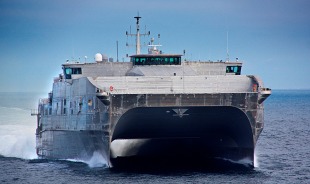
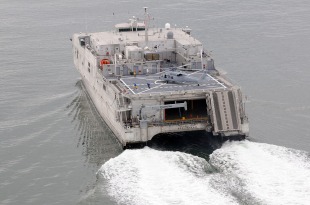
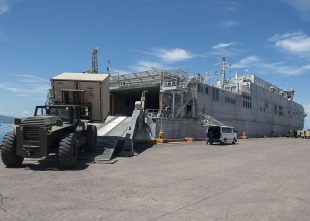
 Military Sealift Command (MSC)
Military Sealift Command (MSC)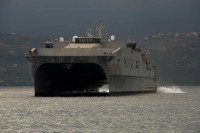
 United States Navy
United States Navy